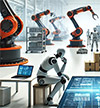Navigating the Digital Transformation
Courtney Dunbar, site selection lead at Burns & McDonnell, recently asked Matt Olson, Burns & McDonnell’s chief innovation officer, about how companies are navigating the digital transformation and its potential of fostering sustainable, resilient manufacturing practices.
Q1 2024
Olson: The COVID-19 pandemic delivered a harsh blow to the U.S. economy, triggering a deep recession and uneven recovery. While the government intervened with stimulus measures, industries reliant on in-person interaction like travel and retail were hit hard. However, this crisis also spurred a dramatic shift towards digitalization.
Lockdowns and social distancing measures necessitated a rapid adoption of remote work, benefiting industries like telecommunications and cloud computing. Consumers turned to online shopping, boosting e-commerce and logistics sectors. Businesses across various fields accelerated automation processes to adapt to labor shortages. These trends exposed the limitations of traditional models and highlighted the need for a digital future.
This realization ushered in the “digital transformation.” Businesses embraced digital tools like cloud solutions and collaboration software. The remote work trend normalized, fostering a long-term shift in work culture and the growth of the digital workforce. The pandemic also exposed the critical need for robust digital infrastructure, paving the way for investments in reliable broadband Internet to support remote activities across various sectors.
Dunbar: How does the digital transformation impact corporate site selection, particularly in the context of electricity consumption and the expansion of energy prospectors?
The landscape of corporate site selection…now prioritizes access to electricity as a primary determinant. Olson: The landscape of corporate site selection, particularly for clean energy components and advanced technology manufacturers, now prioritizes access to electricity as a primary determinant. The market’s focus has shifted toward transmission-adjacent properties, experiencing high demand from manufacturers, data centers, and various sectors vying for real estate along high-voltage corridors — electron superhighways spanning nearly 160,000 miles. This shift underscores the strategic importance of transmission-adjacent real estate in the corporate site selection process.
In addition, the recognition of supply chain leakage for critical components to support products produced in the U.S. has led to heightened demand for either reshoring or manufacturing duplicity that is putting significant strain on power availability. Aging transmission and distribution infrastructure, coupled with rising demand, has led to an environment where electric demand is outpacing electric availability.
Dunbar: How do labor force constraints, e-commerce trends, and the rise of cloud computing contribute to the increasing electricity consumption in industries?
Olson: The motivators pushing industrial occupiers toward higher levels of electricity consumption are multifaceted. Labor force constraints, including a shortage of skilled workers, coupled with the ascent of e-commerce and the demand for cloud computing, are compelling corporations to analyze more data and operate with fewer people. The resultant digital economy underscores the significance of transmission-adjacent real estate, making it a forefront consideration in the site selection process.
Dunbar: How can technology address labor shortages in manufacturing facilities, especially in the context of the digital transformation?
Olson: Technology plays a pivotal role in addressing labor shortages by leveraging advanced automation and robotics. The digital transformation, characterized by the bridge between digital possibilities and industrial realities built with electrons, aligns with the implementation of technology in manufacturing. Automation handles repetitive tasks, freeing up human workers for more complex roles. Predictive analytics and workforce management software are valuable tools that can help forecast potential labor shortages, enabling proactive adjustments in staffing levels and the implementation of training programs.
Dunbar: How can manufacturing facilities reduce their carbon footprint, and how does this align with the broader push toward sustainability in the industrial sector?
Technology plays a pivotal role in addressing labor shortages by leveraging advanced automation and robotics. Olson: Achieving sustainability involves adopting eco-friendly practices and leveraging technology. The focus on renewable energy sources, energy-efficient machinery, smart building technologies, and energy storage in manufacturing facilities mirrors the broader industrial push toward a lower carbon footprint. Many industrial processes need heat, driving industrial carbon emissions; by using thermal heat batteries, we can turn low-carbon intermittent energy sources into reliable 24/7 power sources needed for industrial work. By integrating these technologies, manufacturing facilities contribute to reducing environmental impact and promoting leaner, more efficient operations with lower goods costs.
Dunbar: How can technology enhance supply chain resilience, and what role does it play in addressing disruptions?
Olson: Technology is instrumental in enhancing supply chain resilience through real-time monitoring, analytics tools, and blockchain technology. The ability to identify potential issues early on, coupled with transparency and traceability offered by blockchain, reduces the risk of disruptions. Artificial Intelligence (AI) assists in demand forecasting and inventory management, enabling swift responses to fluctuations in demand or disruptions in the supply chain. Collaborative platforms and communication tools facilitate seamless coordination among teams, suppliers, and partners, making the supply chain more agile and resilient.
Dunbar: Considering the broader context, how do the recent U.S. economic development announcements and pressures impact the future of industrial real estate strategy, and what role does risk mitigation play in site selection?
The focus on renewable energy sources…in manufacturing facilities mirrors the broader industrial push toward a lower carbon footprint. Olson: Recent economic development announcements and pressures, coupled with the digital transformation, continue to reverberate through 2024. Risk mitigation, a core aspect of site selection, demands a higher degree of collaboration. While electric service delivery and scalability remain crucial, they must be managed alongside considerations such as water availability, labor demands, supply chain modeling, and other real estate criteria. Industrial occupiers are urged to adopt a utility-first and an all-of-the-above approach to site selection.
Dunbar: How do these technological advancements collectively shape the industrial landscape, and what should industrial facilities prioritize in the ever-evolving era of the electron?
Olson: The intersection of industry and innovation represents a transformative force shaping the industrial landscape. The integration of technology not only addresses specific challenges such as labor shortages, environmental sustainability, and supply chain resilience but also presents a holistic approach to industrial development. Industrial facilities should prioritize the seamless integration of digital solutions, recognizing the synergies between the digital transformation and sustainable, resilient manufacturing practices. By embracing these advancements, they position themselves for long-term success in an era defined by rapid technological evolution and industrial innovation.
Project Announcements
Australia-Based Aquatic Leisure Technologies Group Plans Opp, Alabama, Manufacturing Operations
12/11/2025
Teradyne Plans Wixom, Michigan, Robotics Operations
12/11/2025
Robinson Plans Altoona, Iowa, Manufacturing Operations
12/11/2025
BioTouch Expands Columbus, Georgia, Operations
12/11/2025
Natrion Plans Erie County, New York, Battery Components Operations
12/11/2025
Czech-Based GZ PrintPak Expands Mount Pleasant, Wisconsin, Manufacturing Operations
12/11/2025
Most Read
-
The Workforce Bottleneck in America’s Manufacturing Revival
Q4 2025
-
Rethinking Local Governments Through Consolidation and Choice
Q3 2025
-
Lead with Facts, Land the Deal
Q3 2025
-
Investors Seek Shelter in Food-Focused Real Estate
Q3 2025
-
America’s Aerospace Reboot
Q3 2025
-
The Permit Puzzle and the Path to Groundbreaking
Q3 2025
-
Supply Chain Whiplash Reshapes CRE
Q3 2025



